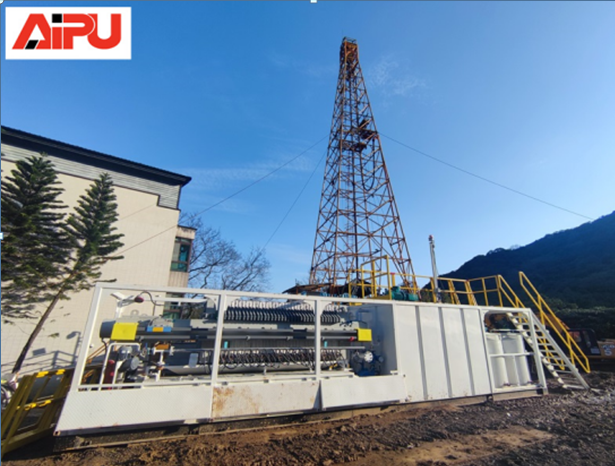Optimize Drilling Operations with Advanced Equipment
Solids control equipment plays a crucial role in oilfield drilling. It helps in separating the drilled solids from the drilling fluid, ensuring the fluid's quality and the efficiency of the drilling process. Here are some top - rated solids control equipment.
Shale Shakers
Shale shakers are the first line of defense in solids control. They are designed to remove large cuttings from the drilling fluid. These machines use a vibrating screen to separate the solids from the liquid. The screens come in different mesh sizes, allowing for the separation of various particle sizes. High - quality shale shakers are known for their high - frequency vibration, which ensures efficient separation. They are also designed to be durable, with robust frames and reliable motors. Some shale shakers are equipped with adjustable decks, which can be tilted to optimize the flow of the drilling fluid and improve the separation efficiency.
Desanders and Desilters
Desanders and desilters are used to remove medium - sized particles from the drilling fluid after the shale shakers have removed the large cuttings. Desanders typically handle larger particles, while desilters deal with smaller ones. These devices work on the principle of hydrocyclones. The drilling fluid is pumped into the hydrocyclones at high speed, creating a centrifugal force. The solids are forced to the outer wall of the hydrocyclone and are then discharged, while the clean fluid exits from the top. High - performance desanders and desilters are characterized by their precise separation capabilities and low maintenance requirements. They are often made of wear - resistant materials to withstand the abrasive nature of the drilling fluid and solids.
Centrifuges
Centrifuges are used for the final stage of solids control, removing fine particles from the drilling fluid. They operate at high speeds, creating a strong centrifugal force that separates the solids from the liquid. There are two main types of centrifuges used in oilfield drilling: decanter centrifuges and disk stack centrifuges. Decanter centrifuges are more commonly used and are known for their ability to handle a wide range of particle sizes. They can be adjusted to control the separation efficiency based on the specific requirements of the drilling operation. Disk stack centrifuges, on the other hand, are more suitable for applications where extremely fine particle separation is needed. They are highly efficient but may require more maintenance compared to decanter centrifuges.
Mud Cleaners
Mud cleaners are a combination of desanders, desilters, and a shale shaker. They provide a comprehensive solution for solids control in a single unit. Mud cleaners are designed to be compact and efficient, reducing the footprint on the drilling site. They can handle a large volume of drilling fluid and effectively remove a wide range of particle sizes. The integrated design of mud cleaners ensures that the drilling fluid goes through multiple stages of separation in a continuous process, resulting in a cleaner and more efficient drilling fluid. This helps in reducing the wear and tear on the drilling equipment and improving the overall performance of the drilling operation.

Shale Shakers
Shale shakers are the first line of defense in solids control. They are designed to remove large cuttings from the drilling fluid. These machines use a vibrating screen to separate the solids from the liquid. The screens come in different mesh sizes, allowing for the separation of various particle sizes. High - quality shale shakers are known for their high - frequency vibration, which ensures efficient separation. They are also designed to be durable, with robust frames and reliable motors. Some shale shakers are equipped with adjustable decks, which can be tilted to optimize the flow of the drilling fluid and improve the separation efficiency.
Desanders and Desilters
Desanders and desilters are used to remove medium - sized particles from the drilling fluid after the shale shakers have removed the large cuttings. Desanders typically handle larger particles, while desilters deal with smaller ones. These devices work on the principle of hydrocyclones. The drilling fluid is pumped into the hydrocyclones at high speed, creating a centrifugal force. The solids are forced to the outer wall of the hydrocyclone and are then discharged, while the clean fluid exits from the top. High - performance desanders and desilters are characterized by their precise separation capabilities and low maintenance requirements. They are often made of wear - resistant materials to withstand the abrasive nature of the drilling fluid and solids.
Centrifuges
Centrifuges are used for the final stage of solids control, removing fine particles from the drilling fluid. They operate at high speeds, creating a strong centrifugal force that separates the solids from the liquid. There are two main types of centrifuges used in oilfield drilling: decanter centrifuges and disk stack centrifuges. Decanter centrifuges are more commonly used and are known for their ability to handle a wide range of particle sizes. They can be adjusted to control the separation efficiency based on the specific requirements of the drilling operation. Disk stack centrifuges, on the other hand, are more suitable for applications where extremely fine particle separation is needed. They are highly efficient but may require more maintenance compared to decanter centrifuges.
Mud Cleaners
Mud cleaners are a combination of desanders, desilters, and a shale shaker. They provide a comprehensive solution for solids control in a single unit. Mud cleaners are designed to be compact and efficient, reducing the footprint on the drilling site. They can handle a large volume of drilling fluid and effectively remove a wide range of particle sizes. The integrated design of mud cleaners ensures that the drilling fluid goes through multiple stages of separation in a continuous process, resulting in a cleaner and more efficient drilling fluid. This helps in reducing the wear and tear on the drilling equipment and improving the overall performance of the drilling operation.








